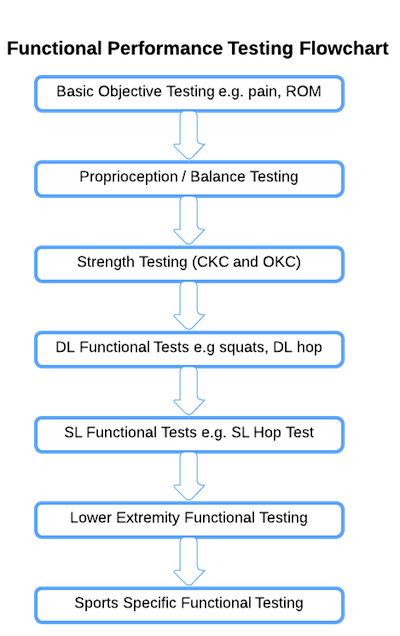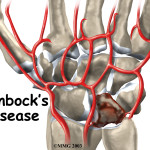As a sports physiotherapist, it is important that you not only rehabilitate athletes but ensure that they are fully fit to return to play. As many of you are fully aware, objective measures such us a full active range of motion does not determine an athlete’s readiness to RTP. Accordingly, a comprehensive assessment of an athlete’s function, via functional performance testing, becomes an absolute assessment necessity. This article will discuss current research on the the role and implementation of functional performance testing, as well as some tests that you may use in your own clinical practice.
What Do We Know About Functional Performance?
As previously suggested, it is essential that we as physiotherapists assess all elements of function. This may seem like commonsense (which they say is not common), however, in orde for an athlete to effectively perform their high level sports they require:
- Strength and Power
- Speed
- Endurance
- ROM and Flexibility
- Balance and Proprioception
- Agility
- Functional and safe movement patterns (Reiman & Manske, 2013)
This is shown in the venn diagram below, which has been recreated from the work of Reiman & Manske (2009). Whilst many of these outcomes can be assessed using traditional or standard clinical examination methods, such as manual muscle testing or goniometry, these may miss functional issues that the rehabilitating athlete still has.
This is readily identified by the work of Bohannon (2005) which showed the sensitivity of manual muscle testing to deficits between sides or relative to normal never exceeded 75%! Furthermore, Murphy and Wilson (1997) found no relationship between training-induced changes in strength and athletic performance. Finally, we are all aware of the questionable relationship between flexibility and athletic performance or injury risk (Ingraham, 2003).
So, how can we test the ability of our athletes to safely return to play and perform athletically? With functional performance testing, of course.
Essential Components of Functional Performance Testing (click to enlarge)
The Role of Functional Performance Testing in Assessing RTP Capacity
First, a definition fo what functional performance testing actually is. Reiman and Maske (2009) defined FPT as
A variety of physical skills and tests to determine:
1. One’s ability to participate at the desired level in sport, occupation, and recreation or to return to participation in a safe and timely manner without functional limitations; and
2. One’s ability to move through up to three planes of movement as determined via non-traditional testing that provides qualitative and quantitative information related to specialized motions involved in sport, exercise, and occupations.
Now that’s quiet a long and wordy definition, but it has some incredibly important points. The first is the need for you to determine the safety and timeliness of someone’s return to play. As an example, despite full ROM and strength measures I would not allow an athlete to RTP at 8 weeks following ACL reconstruction, given what we know about graft revascularisation and healing timeframes (as Dr Mulford says; you can’t beat biology).
Another important insight is the need for 3 planes of movement to be assessed! The importance of this notion becomes abundantly clear when you think of clinical examples, such as a hamstring strain. This athlete may perform without issue in frontal plane exercises, but be unable to effectively perform saggital tests. Furthermore, an athlete with a groin strain may have the opposite problem!
Finally, and possibly most importantly, is the ability of functional performance testing to provide us with qualitative and quantitative information. Take for example, a single leg 3 hop test. Whilst there are no doubt the numbers (distance in cm) are important, physiotherapists can often get more information from carefully watching the athlete perform the functional performance test. As an example, watch the takeoff and landing strategies the athlete uses during a vertical jump test:
- Are they using arm, trunk, hip, knee or ankle strategies more dominantly?
- What is the position of the femur (the highly feared adduction or internally rotation)
- Is the landing soft or heavy? If so, why?
Of course, I could go on… but just keep in mind there is more to discover than the athlete having a 68cm vertical jump.
Implementing Functional Performance Testing
As with most things in the world of sports physiotherapy, there are no recipes here. However, there are general guiding principles! It is essential that you select appropriate tests for your athlete, considerations include:
- Safety
- Relevance
- Specificity
- Practicality (Reiman & Mankse, 2013)
There is no point attempting single leg hops in an athlete following ankle sprain if they cannot perform a single leg calf raise, in fact it’s unsafe! Therefore, you must utilise a progressive system with objective criteria for progression to the next phase (see flowchart below).
Functional Testing Flowchart
As you can see the flowchart progressively moves through assessments that increase the challenge on the injured/healing tissues and the overall function of the athlete. Essentially, you will begin by assessing the function of part of the person and eventually assess the function of the person (Reiman and Mankse, 2011).
As you progress through the testing regime you should remember that every athlete is different, and accordingly your functional performance tests should therefore be varied between athletes. Remember:
The best test of ability to return to sport is one that closely mimics that activity
Examples of Useful Functional Tests
Below are some examples and discussions of some potentially useful functional performance tests you may wish to integrate into your clinical practice.
Trunk Power Testing
Overhead Medicine Ball Throw
Side Medicine Ball Throw
These tests can be used to assess differences between sides. Measures of distance are most useful when the test is repeated, and Stockbrugger and Haennel (2001) demonstrated high test-retest reliability in the overhead med ball throw.
Lower Limb Testing
Speed/Agility – T Test
This test has been shown to be highly reliable, and correlates with a number of physical measures including leg speed, leg power, and agility (Pauole et al., 2000). Unfortunately, as discussed in our post on identifying deficits in late stage ACL rehabilitation, this test may lack the sensitivity to identify between side deficits/asymmetries. In the article, Myer et al. (2011) suggests that deficits identified on single leg testing (see vid below) may be masked during bipedal functional tests.
Single Leg Hop Testing (Great Vid)
As suggested above, these tests can be utilised to determine side-to-side differences in lower limb injuries. However, we have also discussed the importance of assessing the quality of movement or function. Orishimo et al. (2010) identified multiple biomechanical faults/adaptations during single leg testing in the ACL reconstructed knee despite having similar distance measures (mean 93%) including:
- 25% reduction in knee motion during takeoff
- 40% reduction in peak knee moment during takeoff
- 38% reduction in peak knee power during takeoff
- 18% reduction in knee motion during landing
- 43% reduction in peak power absorption
Thus, it is easy to see that the body is able to make compensations through the other lower limb joints. It is important to be aware of such adaptations, and consider the potential for predisposition to further or even other injuries…
Upper Limb Functional Testing
Medicine Ball Throw (Supine or Seated Positions Are Best)
Drop Push Ups (from varying heights)… love the commentary
Limitations of Clinical Use of FTP
Unfortunately, the clinical use of functional performance tests have not been widely studies. Therefore, there are a few limitations on the clinical use of FTP. Many tests have not undergone validity and reliability testing, which weakens their use as re-assessment tools. Normative values are often unknown, particularly in different groups of the population. There is also a lack of standardisation, as we are unsure whether tests are stand-alone or should be performed as part of a battery.
Finally, we do not know which tests are best for predicting successful return to play. Whilst I am sure we all agree these functional performance tests an assessment necessity before allowing an athlete to return to play, we do not know which tests will give us the most valuable information about re-injury risk. We can only design a testing regime that closely mimics the activity and hope for the best!
Take Home Messages and Caveats
- The best functional performance tests assess all elements of function (listed above)
- First assess the function of part of the person and then eventually assess the function of the person
- The best test of ability to return to sport is one that closely mimics that activity
- Every athlete is an individual – and should be assessed accordingly
- There are multiple limitations in the clinical use of FTP
What Are Your Thoughts?
What are your experiences with functional performance testing. I would love to know so be sure to let me know in the comments or you could:
Promote Your Clinic: Are you a physiotherapist or physical therapist looking to promote your own clinic? Check this out.
References
Bohannon RW. Manual muscle testing: does it meet the standards of an adequate screening test? Clin Rehabil 2005;19(6):6662-667
Ingraham SJ. The role of flexibility in injury prevention and athletic performance: have we stretched the truth? Minn Med 2003;86(5):58-61.
Murhy AJ, Wilson GJ. The ability of tests of muscular function to reflect training-induced changes in performance. Journal of Sports Sciences 1997;15(2):191-200
Myer GD, Schmitt LC, Brent JL, Ford KR, Foss KDB, Scherer BJ, Heidt RS, Divine JG, Hewett TE. Utilization of modified NFL combine testing to identify functional deficits in athletes following ACL reconstruction. J Orthop Sports Phys Ther 2011;41(6):377-387
Orishimo KF, Kremenic IJ, Mullaney MJ, McHugh MP, Nicholas SJ. Adaptations in single-leg hop biomechanics following anterior cruciate ligament reconstruction. Knee Surg Sports Traumatol Arthrosc. 2010;18:1587-1593.
Pauole K, Madole K, Garhammer J, Lacourse M, Rozenek R. Reliability and Validity of the T-Test as a Measure of Agility, Leg Power, and Leg Speed in College-Aged Men and Women. Journal of Strength and Conditioning Research 2000;14(4):443–450.
Reiman MP, Manske RC. Functional Testing in Human Performance. Champaign, IL: Human Kinetics; 2009.
Reiman MP, Manske RC. The assessment of function: How is it measured? A clinical perspective. J Man Manip Ther. 2011 May; 19(2): 91–99.
Reiman MP, Manske RC. Functional Performance Testing for Power and Return to Sports. Sports Health: A Multidisciplinary Approach 2013;5:244
Stockbrugger BA, Haennel RG. Validity and reliability of a medicine ball explosive power test. J Strength Cond Res. 2001;15(4):431-438.
Image Credit: Katie Haugland
Related Posts










